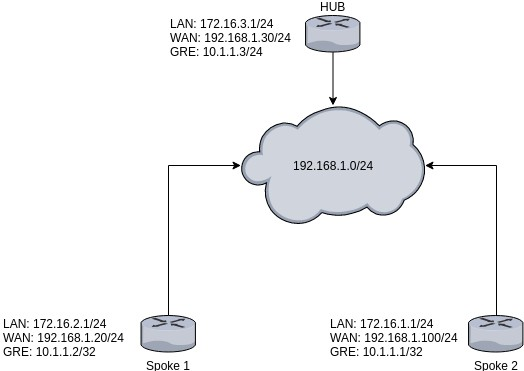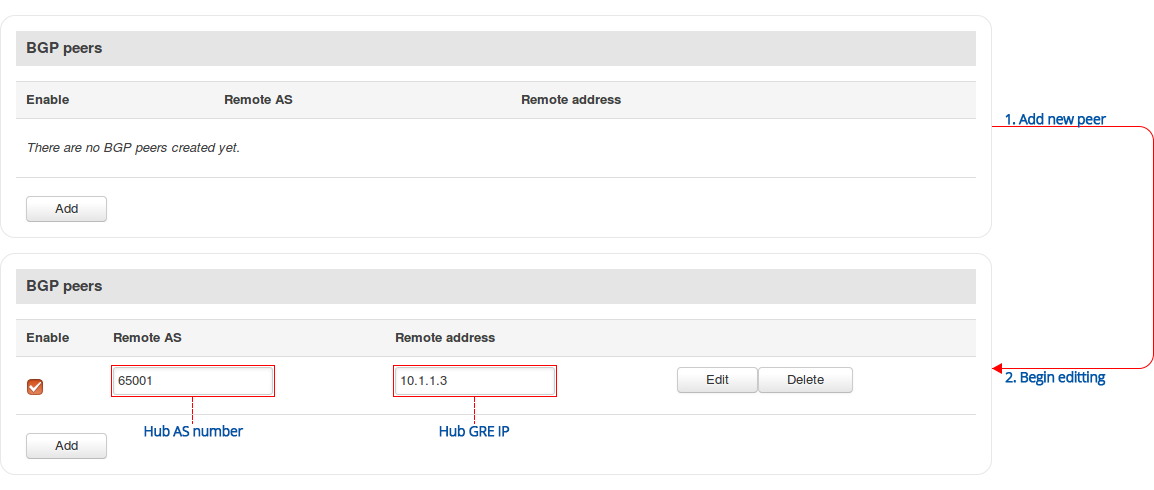DMVPN configuration: Difference between revisions
No edit summary |
|||
| (12 intermediate revisions by 4 users not shown) | |||
| Line 10: | Line 10: | ||
<li>At least two RUT9xx routers</li> | <li>At least two RUT9xx routers</li> | ||
<li>A PC to configure the routers</li> | <li>A PC to configure the routers</li> | ||
<li>(optional) A Cisco router</li><li>HUB has to be reachable from spokes (HUB must have Public IP address, or has to be in the same WAN network as Spokes) | |||
</li> | |||
</ul> | </ul> | ||
---- | ---- | ||
| Line 18: | Line 20: | ||
==Spoke configuration== | ==Spoke configuration== | ||
This section contains information on how to configure DMVPN <b>Spokes</b>. | This section contains information on how to configure DMVPN <b>Spokes</b>. Firstly, we'll configure the DMVPN instance to make to the connection possible. Then we'll set the <b>Border Gateway Protocol</b> (<b>BGP</b>) parameters as our dynamic routing solution. | ||
<b>Note</b>: at the moment, BGP is the only stable dynamic routing solution that can work with DMVPNs. | |||
===Spoke configuration: DMVPN=== | ===Spoke configuration: DMVPN=== | ||
| Line 44: | Line 48: | ||
<b>Step 1</b>: enable BGP:<br>[[File:Dmvpn_5_1_v1.png]] | <b>Step 1</b>: enable BGP:<br>[[File:Dmvpn_5_1_v1.png]] | ||
---- | ---- | ||
<b>Step 2</b>: configure BGP instance:<br>[[File: | <b>Step 2</b>: configure BGP instance:<br>[[File:Dmvpn_5_2_v1.png]] | ||
---- | ---- | ||
<b>Step 3</b>: configure BGP peer:<br>[[File: | <b>Step 3</b>: configure BGP peer:<br>[[File:Dmvpn_5_3_v1.png]] | ||
---- | ---- | ||
<b>Step 4</b>: save changes | <b>Step 4</b>: save changes | ||
| Line 80: | Line 84: | ||
---- | ---- | ||
<b>Step 4</b>: save changes | <b>Step 4</b>: save changes | ||
==Cisco configuration== | |||
If you plan on using a Cisco router with this topology, you can use the configuration provided in this section. The configuration is set in accordance with the configuration scheme in [[DMVPN_configuration#Prerequisites_and_overview|section 2]] of this article. | |||
===Cisco Spoke configuration: DMVPN=== | |||
---- | |||
crypto isakmp policy 1 | |||
encr aes | |||
hash md5 | |||
authenticatio pre-share | |||
group 5 | |||
! | |||
crypto isakmp key 1234 address 192.168.1.30 | |||
! | |||
! | |||
crypto ipsec transform-set DMVPN-TS esp-3des esp-md5-sha256 | |||
mode transport | |||
! | |||
crypto ipsec profile DMVPN | |||
set security-association lifetime secnds 86400 | |||
set transform-set DMVPN-TS | |||
! | |||
interface Tunnel0 | |||
description mGRE - DMVPN Tunnel | |||
ip address 10.1.1.1 255.255.255.0 | |||
ip nhrp network-id 1 | |||
ip nhrp nhs 10.1.1.3 nbma 192.168.1.30 | |||
ip nhrp shortcut | |||
ip nhrp redirect | |||
tunnel source GigabitEthernet0/0/1 | |||
tunnel destination 192.168.1.30 | |||
tunnel key 1234 | |||
tunnel protectio ipsec profile DMVPN | |||
! | |||
interface GigabitEthernet0/0/1 | |||
description Wired DMVPN | |||
ip address 192.168.1.100 255.255.255.0 | |||
negotiation auto | |||
===Cisco Spoke configuration: BGP=== | |||
---- | |||
router bgp 65002 | |||
bgp log-neighbor-changes | |||
network 10.1.1.0 mask 255.255.255.0 | |||
neighbor spokes-ibgp peer-group | |||
neighbor spokes-ibgp remote-as 65001 | |||
neighbor spokes-ibgp route-reflector-client | |||
neighbor spokes-ibgp soft-reconfiguration inbound | |||
neighbor 10.1.1.3 peer-group spokes-ibgp | |||
===Cisco Hub configuration=== | |||
---- | |||
interface Tunnel0 | |||
description mGRE - DMVPN Tunnel | |||
ip address 10.1.1.3 255.255.255.0 | |||
ip nhrp network-id 1 | |||
ip nhrp nhs dynamic nbma multicast | |||
ip nhrp shortcut | |||
ip nhrp redirect | |||
tunnel source GigabitEthernet0/0/1 | |||
tunnel key 1234 | |||
tunnel protection ipsec profile DMVPN | |||
! | |||
router bgp 65001 | |||
bgp log-neighbor-changes | |||
network 10.1.1.0 mask 255.255.255.0 | |||
neighbor spokes-ibgp peer-group | |||
neighbor spokes-ibgp remote-as 65001 | |||
neighbor spokes-ibgp route-reflector-client | |||
neighbor spokes-ibgp soft-reconfiguration inbound | |||
neighbor 10.1.1.3 peer-group spokes-ibgp | |||
neighbor 10.1.1.2 peer-group spokes-ibgp | |||
Latest revision as of 08:04, 8 January 2021
Introduction
Dynamic Multipoint VPN (DMVPN) is a dynamic tunneling form of a virtual private network (VPN) supported on Cisco routers. This article contains step-by-step instructions on how to configure DMVPN between a "Hub" and two "Spokes" using RUT9xx routers.
Prerequisites and overview
You will need:
- At least two RUT9xx routers
- A PC to configure the routers
- (optional) A Cisco router
- HUB has to be reachable from spokes (HUB must have Public IP address, or has to be in the same WAN network as Spokes)
Configuration scheme:
Spoke configuration
This section contains information on how to configure DMVPN Spokes. Firstly, we'll configure the DMVPN instance to make to the connection possible. Then we'll set the Border Gateway Protocol (BGP) parameters as our dynamic routing solution.
Note: at the moment, BGP is the only stable dynamic routing solution that can work with DMVPNs.
Spoke configuration: DMVPN
Navigate to the Services → VPN → DMVPN page and follow the instructions provided below.
Step 1: create a new DMVPN instance: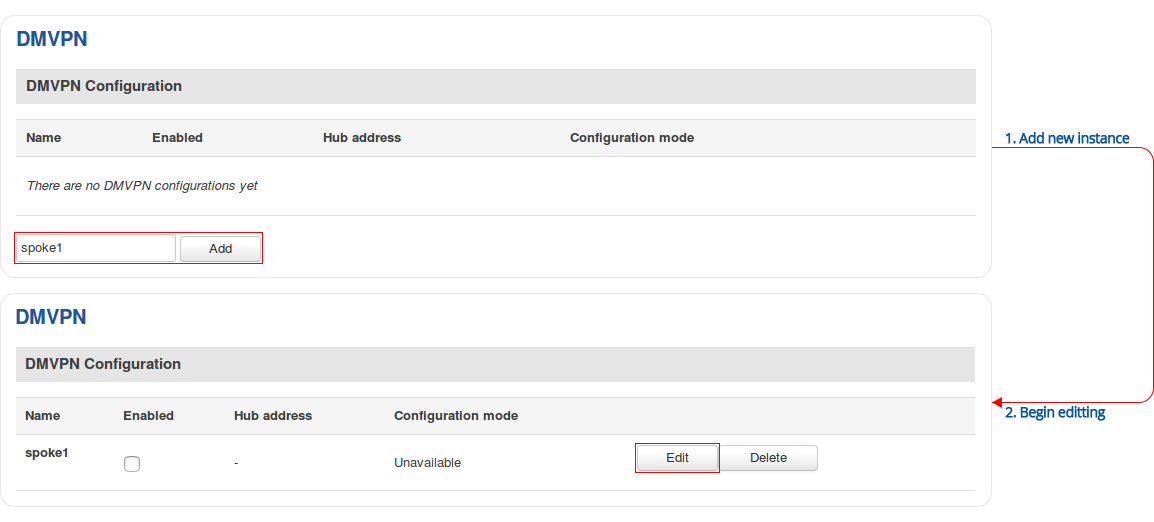
Step 2: configure DMVPN parameters:
Step 3: configure GRE parameters:
Step 4: configure IPsec parameters: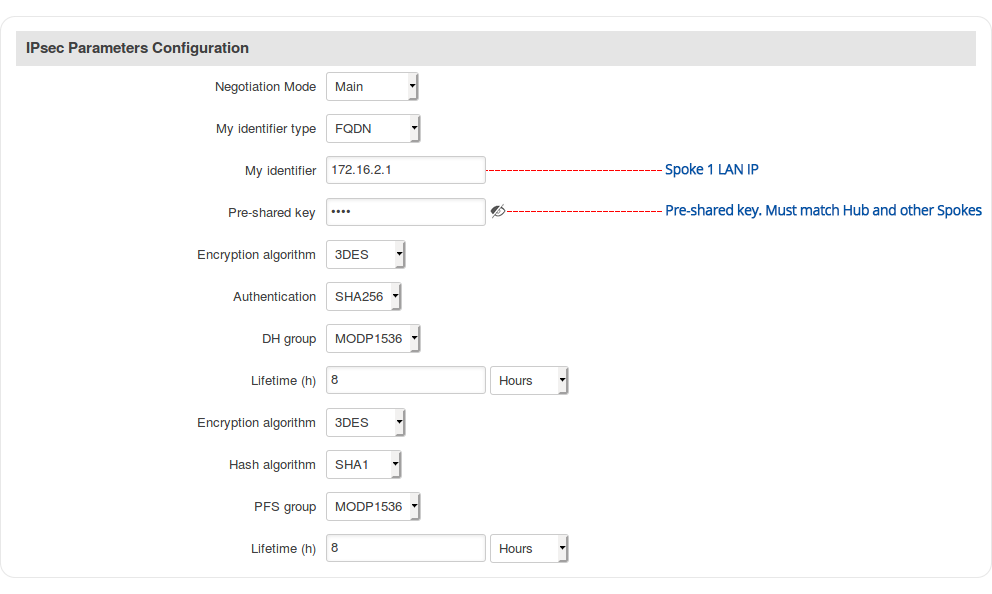
Step 5: configure NHRP parameters or leave default values:
Step 6: save changes
Repeat this on different routers as many times as the number of Spokes that you need. Remember that other Spokes will have different LAN, WAN and GRE IP addresses.
Spoke configuration: BGP
Navigate to the Network → Routing → Dynamic Routes → BGP Protocol page and follow the instructions provided below.
Step 2: configure BGP instance: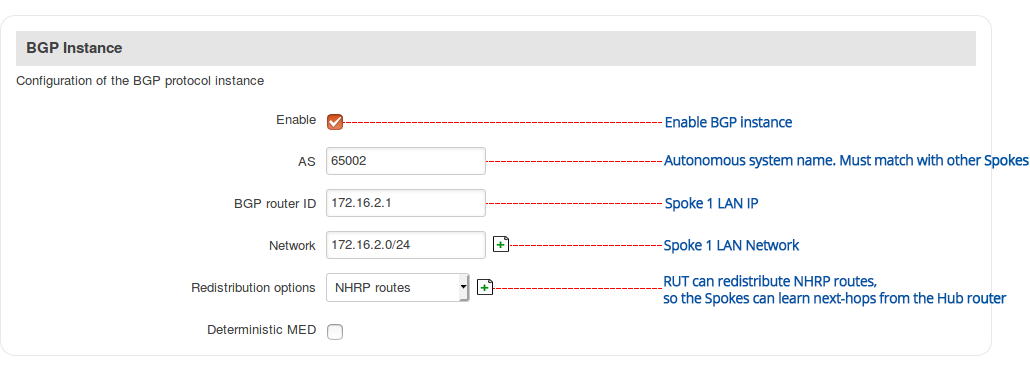
Step 4: save changes
Hub configuration
Hub configuration: DMVPN
Navigate to the Services → VPN → DMVPN page and follow the instructions provided below.
Step 1: create a new DMVPN instance: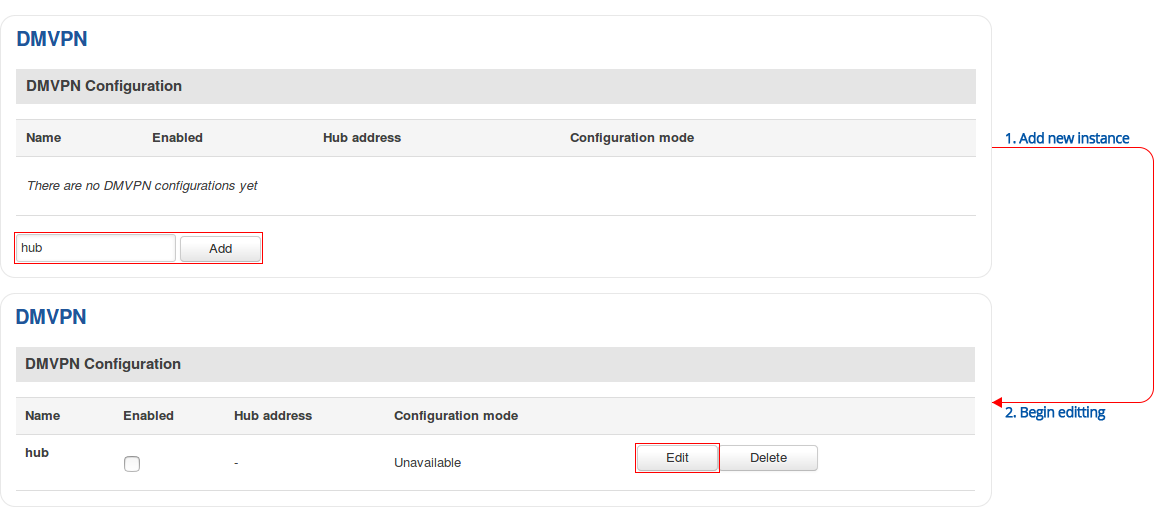
Step 2: configure DMVPN parameters:
Step 3: configure GRE parameters:
Step 4: configure IPsec parameters: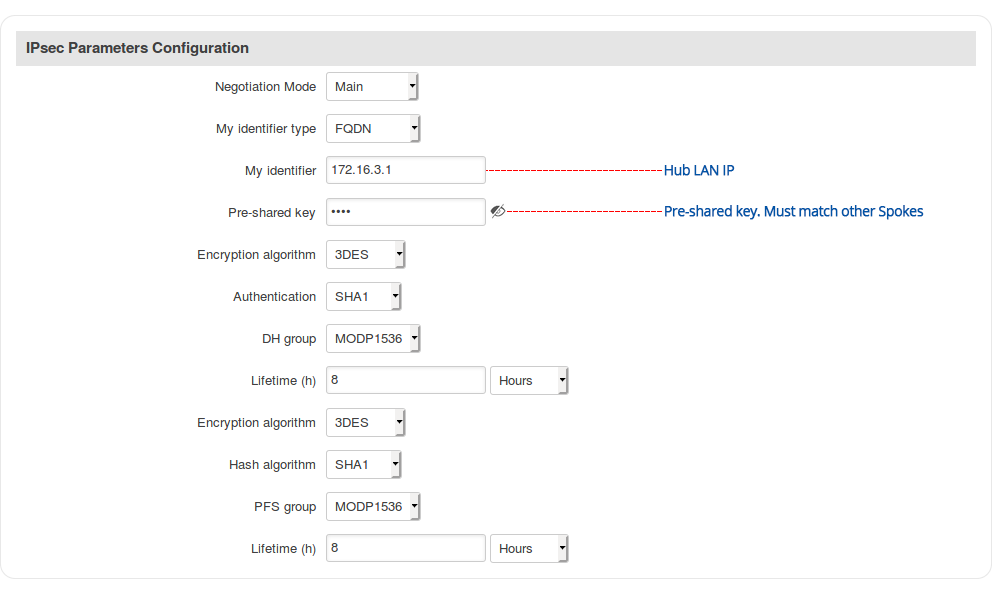
Step 5: configure NHRP parameters or leave default values:
Step 6: save changes
Hub configuration: BGP
Navigate to the Network → Routing → Dynamic Routes → BGP Protocol page and follow the instructions provided below.
Step 2: configure BGP instance: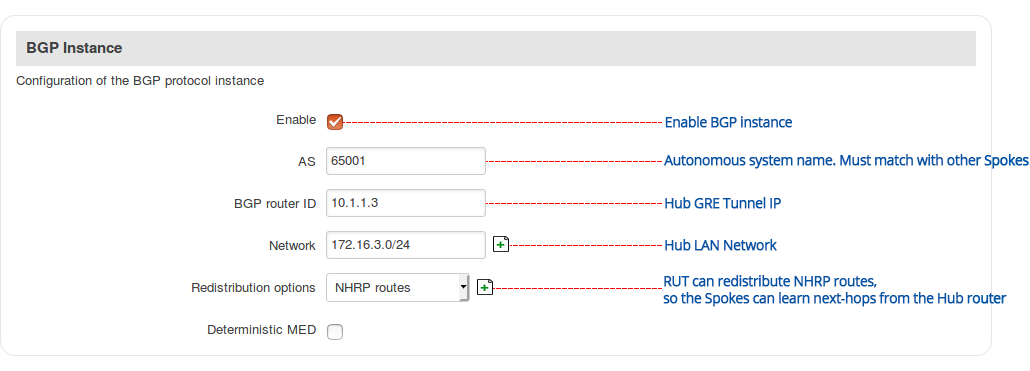
Step 3: configure BGP peer group: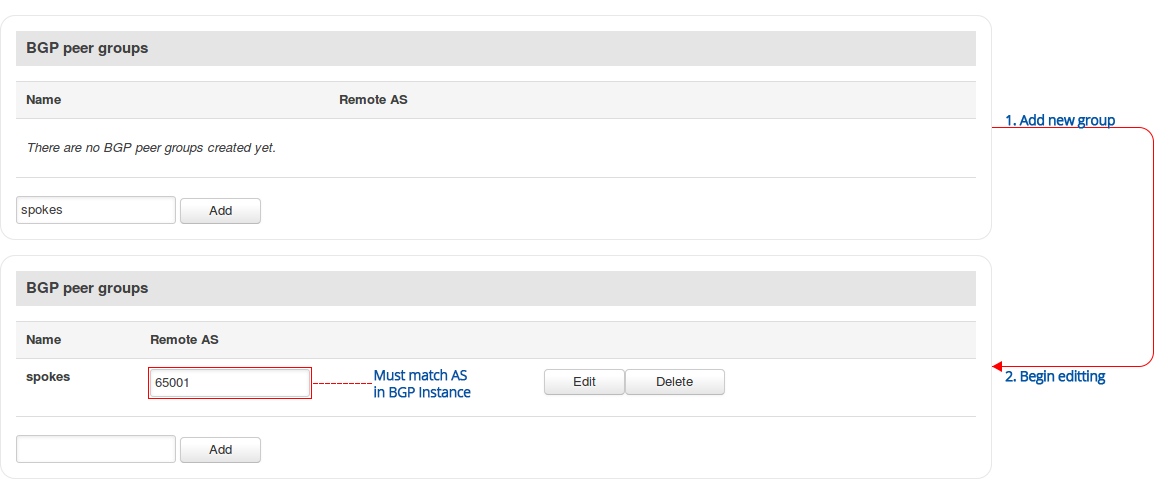
Step 4: save changes
Cisco configuration
If you plan on using a Cisco router with this topology, you can use the configuration provided in this section. The configuration is set in accordance with the configuration scheme in section 2 of this article.
Cisco Spoke configuration: DMVPN
crypto isakmp policy 1 encr aes hash md5 authenticatio pre-share group 5 ! crypto isakmp key 1234 address 192.168.1.30 ! ! crypto ipsec transform-set DMVPN-TS esp-3des esp-md5-sha256 mode transport ! crypto ipsec profile DMVPN set security-association lifetime secnds 86400 set transform-set DMVPN-TS ! interface Tunnel0 description mGRE - DMVPN Tunnel ip address 10.1.1.1 255.255.255.0 ip nhrp network-id 1 ip nhrp nhs 10.1.1.3 nbma 192.168.1.30 ip nhrp shortcut ip nhrp redirect tunnel source GigabitEthernet0/0/1 tunnel destination 192.168.1.30 tunnel key 1234 tunnel protectio ipsec profile DMVPN ! interface GigabitEthernet0/0/1 description Wired DMVPN ip address 192.168.1.100 255.255.255.0 negotiation auto
Cisco Spoke configuration: BGP
router bgp 65002 bgp log-neighbor-changes network 10.1.1.0 mask 255.255.255.0 neighbor spokes-ibgp peer-group neighbor spokes-ibgp remote-as 65001 neighbor spokes-ibgp route-reflector-client neighbor spokes-ibgp soft-reconfiguration inbound neighbor 10.1.1.3 peer-group spokes-ibgp
Cisco Hub configuration
interface Tunnel0 description mGRE - DMVPN Tunnel ip address 10.1.1.3 255.255.255.0 ip nhrp network-id 1 ip nhrp nhs dynamic nbma multicast ip nhrp shortcut ip nhrp redirect tunnel source GigabitEthernet0/0/1 tunnel key 1234 tunnel protection ipsec profile DMVPN ! router bgp 65001 bgp log-neighbor-changes network 10.1.1.0 mask 255.255.255.0 neighbor spokes-ibgp peer-group neighbor spokes-ibgp remote-as 65001 neighbor spokes-ibgp route-reflector-client neighbor spokes-ibgp soft-reconfiguration inbound neighbor 10.1.1.3 peer-group spokes-ibgp neighbor 10.1.1.2 peer-group spokes-ibgp

